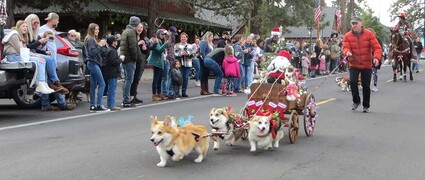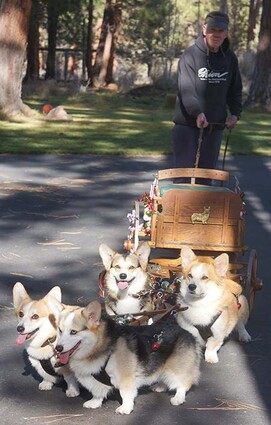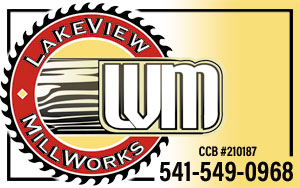Here come the Corgis!
Last updated 12/8/2021 at Noon
When what to my wondering eye should appear, but a miniature sleigh and…
Four tiny Corgis? You bet.
If you are a veteran of the Sisters Christmas Parade, you know that the sleigh-pullers in these parts aren’t reindeer. For the past two decades they’ve been a team of Pembroke Welsh Corgis, worked by Ann Richardson and Clyde Dildine.
The Corgi-team tradition goes back to the 1990s, when Nance Baker of Danceaker Kennels and Laura Joy started running six-dog teams in parades in Redmond and across Central Oregon, as well as exhibitions down into California.
“We actually got our first Corgis from Nance,” Richardson recalled.
Richardson and Dildine had a Great Pyrenees and a Newfoundland — huge dogs — and they were looking for dogs they could travel with and engage in their favorite adventure, river rafting.
“They’re perfect rafting dogs, with that low center of gravity,” Dildine said.
However, it turns out that the packaging on Pembroke Welsh Corgis is somewhat deceptive.
“A Corgi is a very big dog in a small body,” Richardson said.
Bred as cattle dogs, the Corgi is emphatically not a cute lap dog (see sidebar).
Richardson and Dildine took the baton with the Corgi parade team, using Joy’s wagon and harness. (Yes, they don’t actually pull a sleigh — it’s a scale replica of a buckboard wagon). In this year’s Sisters Christmas Parade, the team consisted of Groover (owners, Ann Richardson and Clyde Dildine), Garth (owner, Lisa Joy); and Gus & Rosie, aka Guns n Roses (owner, Diane Sullivan).
There’s a lot more that goes into running a Corgi team in a parade than one might think.
“You don’t just throw the dogs on there and say, ‘Have fun,’ Joy said.
The dogs need to be at least 18 months to 2 years old to handle the physical demands. Some Corgis take to the job, even though it’s not what they’re breed to do; others don’t.
“Either they’re going to do it or they’re not,” Richardson said. “Some of them just say, ‘No, I’m not doing that!’”
It takes a little work to get the dogs accustomed to the harness. Richardson and Dildine put the harness on the dogs and let them walk around in it.
“That’s before they ever see the wagon,” Dildine said.
“You have to test them out in different locations (on the harness),” Richardson noted. Some make better wheel dogs, some are better lead dogs.”
The mushers spend about three weekends before the parade, “just hitching them up and running around the driveway,” to prepare for the big event, Dildine said.
“Then there’s decorating the wagon — which is just a tremendous waste of time, because I don’t think anybody looks at it,” Richardson said with a chuckle.
After all, all the attention is on the scurrying Corgis.
Parade day is no casual event. It takes work to keep the Corgis running down the parade route, looking good. They love kids, so they’ll sometimes veer off to say hi to a youngster on the route. And a team of four little dogs can generate a surprising amount of momentum.
Richardson walks at the front and side of the team, and entices them onward with treats. Dildine is the brakeman.
Richardson explained: “Clyde’s job is to make them stop — and that’s not easy. The brake person is pretty darn critical. He’s not there for show and good looks.”
“Well, good looks, for sure!” Dildine interjected, though he acknowledged that it’s serous work keeping a powerful team under good control. Richardson and Dildine are a team, too, and they are constantly giving each other cues that the crowd along the route probably doesn’t pick up on.
“There’s a tremendous amount of nonverbal communication going on,” Dildine said.
The four-dog team is full of youngsters, which bodes well for the future of the beloved feature of the Sisters Christmas Parade.
“We’ve got a lot of young dogs, so as long as the people hold up…” Richardson said.
In fact, there’s a pretty good chance that the team will be back out on the street for this year’s Sisters Rodeo Parade.
“It’s just so much fun,” Dildine said. “You can hear people say, ‘Here come the Corgis!’ and that’s very gratifying.”















Reader Comments(0)